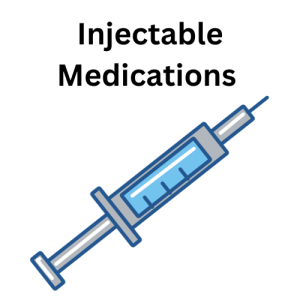
by Russell Noga | Updated November 26th, 2023
 If you’re one of the many men who struggle with erectile dysfunction (ED) and have considered penile implants as a solution, you might be wondering, “Does Medicare cover penile implants?”
If you’re one of the many men who struggle with erectile dysfunction (ED) and have considered penile implants as a solution, you might be wondering, “Does Medicare cover penile implants?”
This article will help you navigate the complexities of Medicare coverage for penile implant surgery while providing you with valuable insights into alternative ED treatments, surgical processes, and useful tips to maximize your Medicare benefits.
Let’s dive into the world of penile implants and Medicare coverage.
Key Takeaways
- Medicare coverage for penile implant surgery is available under Original Medicare and Medicare Advantage plans.
- Out-of-pocket expenses such as deductibles, copayments, and coinsurance may apply. Medigap policies can provide supplemental coverage to reduce costs.
- Alternative treatments such as oral medications, injectable medications, or vacuum devices are also options with varying effectiveness and potential coverage under Medicare.
Medicare Coverage for Penile Implants: The Basics
Medicare, the United States’ health insurance program for people aged 65 and older, provides coverage for a variety of medical services, including penile implant surgery for those who meet the eligibility requirements. But what does this coverage entail, and how does it differ between Original Medicare and Medicare Advantage plans?
Penile implant surgery, a procedure in which a device is surgically implanted to treat erectile dysfunction, may be covered by both Original Medicare and Medicare Advantage if deemed medically necessary. However, be aware that Medicare does not cover the cost of the device itself or any additional treatments or medications related to erectile dysfunction.
In the following sections, we’ll explore the nuances of Medicare coverage for penile implant surgery under Original Medicare and Medicare Advantage.
Original Medicare and Penile Implants
Original Medicare, which consists of Part A (hospital insurance) and Part B (medical insurance), covers penile implant surgery under Part B, as it is classified as an outpatient procedure. Once you’ve met your yearly deductible of $203, Medicare Part B typically covers 80% of the cost of penile implant surgery.
As a patient, you’ll be responsible for the remaining 20% coinsurance.
Bear in mind that Original Medicare does not cover prescription drugs related to erectile dysfunction, such as Viagra or Cialis. You may want to explore additional coverage options, such as a Medicare Advantage plan or a Medigap policy, to help cover these costs, including prescription drug coverage.
Medicare Advantage and Penile Implants
Medicare Advantage plans are offered by private insurance companies as an alternative to Original Medicare. They provide similar coverage as Original Medicare.
These plans also cover penile implant surgery for eligible individuals, as long as the procedure is deemed medically necessary by a physician.
Medicare Advantage plans offer coverage for penile implant surgery, and it’s essential to know whether Medicare cover penile implants or not. The level of coverage will vary depending on the plan.
It is important to check with your plan to find out what it covers. For optimal coverage, it’s recommended to consult with your Medicare Advantage plan provider and comprehend the benefits and limitations of your specific plan.
Discover 2024 Plans & Rates
Enter Zip Code
Types of Penile Implants Covered by Medicare
Medicare covers two types of penile implants: inflatable and malleable, both of which are used to treat erectile dysfunction.
Inflatable penile implants provide a more natural-looking erection and can be inflated or deflated as needed, while malleable penile implants are semi-rigid rods that provide a constant erection but can be bent into different positions.
Let’s examine each type of penile implant in more detail.
 Inflatable Penile Implants
Inflatable Penile Implants
Inflatable penile implants consist of two cylinders implanted in the penis, a fluid-filled reservoir implanted in the abdomen, and a pump placed in the scrotum.
When the pump is activated, fluid is transferred from the reservoir to the cylinders, creating an erection.
To deflate the implant, the pump is squeezed, allowing the fluid to return to the reservoir. Inflatable implants offer a more natural-looking and functioning erection, with high satisfaction rates reported in various studies.
However, inflatable penile implants come with their own set of disadvantages, such as:
- the risk of infection
- possible implant issues
- scarring and penile retraction
- the potential for complications such as spontaneous inflation or mechanical failure
It’s vital to consider the pros and cons of each implant type before making a decision.
Malleable Penile Implants
Malleable penile implants, a type of penile prosthesis, are an alternative to inflatable implants and consist of semi-rigid rods that provide a constant erection. These rods can be bent into different positions, allowing for sexual activity without the need for inflation or deflation.
Advantages of malleable implants include:
- Simplicity: Malleable implants have fewer components, reducing the risk of mechanical failure.
- Reliability: Malleable implants provide a constant erection, eliminating the need for inflation or deflation.
- Ease of use: Malleable implants are easy to use and require minimal maintenance.
While malleable implants may be more straightforward, they do not provide the same natural appearance and functionality as inflatable implants. You should discuss both types of penile implants with your doctor to determine the option that best fits your needs and lifestyle.
 Navigating the Costs of Penile Implant Surgery with Medicare
Navigating the Costs of Penile Implant Surgery with Medicare
Grasping the costs associated with penile implant surgery and how Medicare coverage can help shrink out-of-pocket expenses is important for those pondering this procedure. While Medicare Part B covers 80% of the surgery costs once you’ve met your yearly deductible, you may still have out-of-pocket expenses for deductibles, copayments, and coinsurance.
Exploring additional coverage options such as Medigap policies can help lower these out-of-pocket costs for those with Original Medicare. In the following sections, we’ll delve deeper into the costs related to penile implant surgery and how to navigate them with Medicare.
Out-of-Pocket Expenses
Even with Medicare coverage, patients may still have out-of-pocket expenses for penile implant surgery, including deductibles, copayments, and coinsurance. For example, after meeting the yearly deductible, Medicare Part B typically covers 80% of the penile implant cost, leaving the patient responsible for the remaining 20%.
These out-of-pocket expenses can vary depending on your specific Medicare plan and individual circumstances. It’s advised to consult with your Medicare plan provider and healthcare professional to understand the medicare costs you may carry and investigate additional coverage options if necessary.
Medigap and Penile Implant Surgery
Medigap policies, which are supplemental insurance plans sold by private companies, can help cover some of the out-of-pocket costs associated with penile implant surgery for those with Original Medicare. These policies can assist in covering the portion of costs related to services provided by Original Medicare, including penile implant surgery.
To optimize your Medicare coverage for penile implants, you may want to enroll in a Medigap policy during the open enrollment period, a six-month window that starts when you turn 65 and enroll in Medicare Part B. This can help lower the financial burden of penile implant surgery and ensure you receive the best possible care.
Alternative Treatments for Erectile Dysfunction
For those who may not be eligible for penile implant surgery or prefer to explore other treatment options, there are alternative ED treatments available, including oral medications, injectable medications, and vacuum devices. Each of these options comes with unique advantages and disadvantages, and discussing them with your healthcare professional is key to determining the most suitable treatment for your needs.
In the following sections, we’ll explore these alternative treatments for erectile dysfunction, along with their effectiveness and potential coverage under Medicare.
 Oral Medications
Oral Medications
Oral medications such as Viagra and Cialis can be effective in treating erectile dysfunction by augmenting blood flow to the penis during sexual stimulation.
However, these drugs are currently excluded from coverage under Medicare Part D, which means that patients may need to pay for these medications out-of-pocket or explore other coverage options.
Despite their effectiveness, oral or injectable medications for ED may not be suitable for everyone, especially those with certain health conditions or taking specific medications. You should discuss these choices with your doctor and take into account any potential risks or interactions.
 Injectable Medications
Injectable Medications
Injectable medications, such as papaverine, phentolamine, and prostaglandin E1 (alprostadil), can be an alternative to penile implants for treating erectile dysfunction.
These medications work by relaxing the smooth muscle of the blood vessel walls, enhancing blood flow to the penis, and helping achieve and sustain an erection.
Medicare Part D typically excludes coverage for injectable medications for erectile dysfunction. Still, injectable medications could be a viable treatment option for some individuals, hence it’s important to discuss the potential benefits, risks, and costs with your healthcare professional.
Vacuum Devices
Vacuum devices are another alternative treatment for erectile dysfunction. These devices use a vacuum to draw blood into the penis, enabling the achievement and maintenance of an erection.
Vacuum devices can be purchased without a prescription and may be covered by Medicare in some cases.
Vacuum devices can be a non-invasive and cost-effective option for treating erectile dysfunction. However, they may not provide the same level of spontaneity and natural appearance as penile implants or other treatments.
It’s vital to weigh the pros and cons of using a vacuum device with your healthcare professional to see if this option is suitable for you.
The Penile Implant Surgery Process: From Consultation to Recovery
The penile implant surgery process involves several steps, including consultation, documentation, surgery, and recovery. Understanding each step and what to expect throughout the process is key to ensure the best possible outcome and minimize any potential complications.
In the following sections, we’ll explore each stage of the penile implant surgery process, from the initial consultation with your doctor to the recovery period following the procedure.
 Consultation and Documentation
Consultation and Documentation
Before undergoing penile implant surgery, you’ll need to meet with your doctor to discuss the procedure, assess medical necessity, and determine if you’re a suitable candidate for the surgery.
During the consultation, your doctor may conduct various medical tests, such as presurgical urine tests, blood tests, and a physical exam.
In some cases, more complex testing, like a sophisticated ultrasound of the penis, may also be administered.
To obtain approval for penile implant surgery, you’ll need to provide medical documentation confirming your medical condition and the need for the implant. This documentation should include an evaluation by a board-certified/eligible Urologist and confirmation of the medical necessity of the procedure.
Surgery and Recovery
Penile implant surgery is typically performed on an outpatient basis, meaning you can return home the same day of the procedure.
The surgery itself involves several steps, including:
- Administration of anesthesia
- Making an incision
- Positioning the implant rods or cylinders
- Closing the incision
Following the surgery, the recovery period generally lasts four to six weeks. During this time, you’ll need to manage pain and discomfort with prescribed medications, monitor the incision site, and follow your doctor’s postoperative care instructions.
Adhering to these instructions and communicating any concerns or complications to your doctor is crucial for a smooth recovery process.
Tips for Maximizing Your Medicare Coverage for Penile Implants
For maximizing your Medicare coverage for penile implants, here are some steps to follow:
- Understand the coverage limitations of your Medicare plan.
- Gather the necessary documentation, such as medical records and prescriptions, to support your claim for coverage.
- Explore additional coverage options, such as Medigap policies, that may provide additional financial assistance.
- Consult with your Medicare plan provider and healthcare professional to navigate the complexities of Medicare coverage and ensure you receive the best possible care.
Apart from understanding your specific Medicare coverage, researching and comparing different Medicare plans is crucial, as coverage for penile implant surgery may vary based on the specific plan and individual circumstances.
By taking the time to fully understand your Medicare benefits and exploring additional coverage options, you can minimize out-of-pocket expenses and receive the care you need.
Compare Medicare Plans & Rates in Your Area
Summary
Navigating the world of Medicare coverage for penile implants can be complex, but by understanding the basics of coverage, types of implants, costs, alternative treatments, and the surgery process, you can make informed decisions about your healthcare.
Remember to consult with your healthcare professional and Medicare plan provider to explore all available options and ensure you receive the best possible care.
Take charge of your health and embrace the possibilities that penile implant surgery and alternative treatments can offer.
Compare 2024 Plans & Rates
Enter Zip Code
Frequently Asked Questions
What qualifies you for a penile implant?
If you have ED or Peyronie’s disease and your condition hasn’t responded to conservative treatments, such as medications or a vacuum restriction device (penis pump), then you may be a good candidate for a penile implant.
Does a penile implant work for a man over 65 years old?
Men aged 50-90 years old who have had prostate, bladder or colon cancer treatments or penile deformity/atrophy are good candidates for a penile implant. Thus, a man over 65 years old may benefit from a penile implant.
Does Social Security pay for penile implants?
Unfortunately, Social Security does not pay for penile implants; however, Medigap insurance can cover part of the cost.
What is the average cost of penile implant surgery?
The average cost of penile implant surgery ranges from $12,000 to $19,000. Payment plans are usually available.
Does Medicare cover penile implant surgery?
Yes, Medicare may offer coverage for penile implant surgery if it is deemed medically necessary by your doctor.
Find the Right Medicare Plan for You
Acquiring the right Medicare plan doesn’t have to be confusing. Whether it’s a Medigap plan, or you have questions about Medicare Advantage or Medicare Part D, we can help.
Call us today at 1-888-891-0229 and one of our knowledgeable, licensed insurance agents will be pleased to assist you!

Russell Noga is the CEO and Medicare editor of Medisupps.com. His 15 years of experience in the Medicare insurance market includes being a licensed Medicare insurance broker in all 50 states. He is frequently featured as a featured as a keynote Medicare event speaker, has authored hundreds of Medicare content pages, and hosts the very popular Medisupps.com Medicare Youtube channel. His expertise includes Medicare, Medigap insurance, Medicare Advantage plans, and Medicare Part D.



